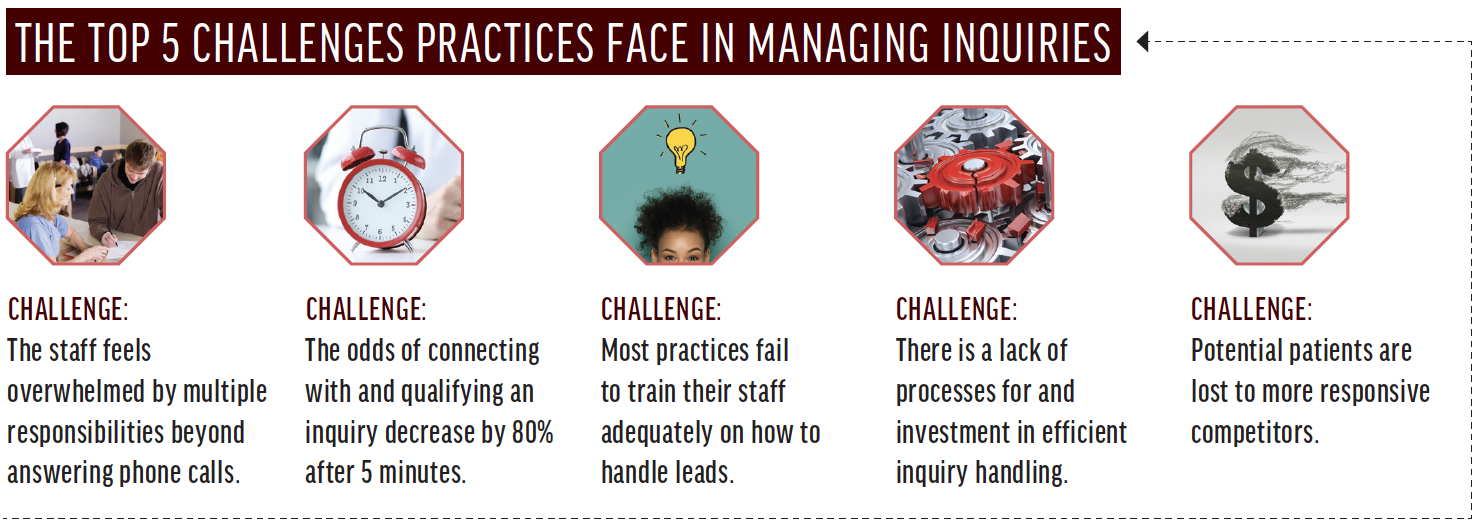

Does your practice respond to website inquiries within 5 minutes? We conducted a poll during a recent webinar with approximately 300 surgeon attendees. Based on the results, it is unlikely that your practice meets the aforementioned response time.
Challenges in Efficiently Managing Inquiries
The most influential person in a clinic is often the one who handles the first inquiries, whether from phone calls, chats, social media, or emails. In our experience, however, practices tend not to employ dedicated sales personnel or provide their staff with sufficient training to perform this critical role effectively. Moreover, with numerous responsibilities beyond answering phone calls, staff may perceive inquiries from potential clients as distractions.
Practices receiving warm referrals may not require perfect sales conversations; order-taking discussions often suffice. When targeting cold audiences through advertising and marketing efforts, however, effective sales conversations are essential for competition. Unfortunately, most of the staff does not know how to handle these leads, resulting in low conversion rates.
The Role of Proactive Follow-up
Following up with cold leads is crucial because these individuals are unlikely to schedule an appointment immediately. A proactive approach can help practices avoid losing potential patients to more responsive competitors.
A study conducted by MIT found that the odds of connecting with and qualifying an inquiry decreased by 80% after 5 minutes elapsed. In contrast, responding within the first minute could increase conversions by 391%.1
The average response time to leads for health care practices is 2 hours and 5 minutes. Response time is significantly shorter in other industries.2 One reason may be that surgeons are often accidental business owners who overlook sales and marketing aspects when establishing their practices. This, in turn, may lead to a lack of processes for and investment in efficiently handling inquiries.
Technological Solutions to Improve Response Time
Technological solutions such as Hattie (LiveseySolar Practice Builders; Figure) provide almost instantaneous two-way SMS responses to inquiries.2 Hattie’s AI-powered chatbots can also convert every missed call into a text conversation, ensuring no lead is overlooked. When someone submits a “call me back” form or completes a test on a website, Hattie can automatically initiate a callback and connect the person with the practice’s staff. Its AI bots can also access the practice’s online booking calendar to guide potential patients through the scheduling process 24 hours a day, 7 days a week.

Figure. The Hattie interface.
Patient coordinators frequently report difficulty with reaching leads who complete forms. One possible reason is that leads ignore follow-up attempts. As the data presented earlier showed, speed is a factor. If your practice takes more than 5 minutes to get back to potential patients, they might have already engaged with another provider.
Lead-response automation can increase your contact rate. This could increase your conversion rate and ultimately your surgical volume. If responding within 5 minutes doubles your contact rate (highly probable in our experience), your number of leads and thus your sales revenue should increase if not double.

Conclusion
To increase the conversion rate from inquiry to appointment and remain competitive, practices must respond to inquiries within 5 minutes. Technological solutions can help practices manage inquiries more efficiently.
1. MIT. The insidesales.com/MIT lead response management study. July 17, 2008. Accessed March 23, 2023. https://www.liveseysolar.com/wp-content/uploads/2022/05/mit_study.pdf
2. Rivera C. Chili Piper. Lead response time (+ 12 speed to lead statistics that show why it matters). September 1, 2021. Accessed March 23, 2023. https://www.chilipiper.com/article/speed-to-lead-statistics
3. LiveseySolar. Grow your practice with Hattie: introducing the world’s first virtual patient coordinator. Accessed March 23, 2023. https://www.liveseysolar.com/hattie/


